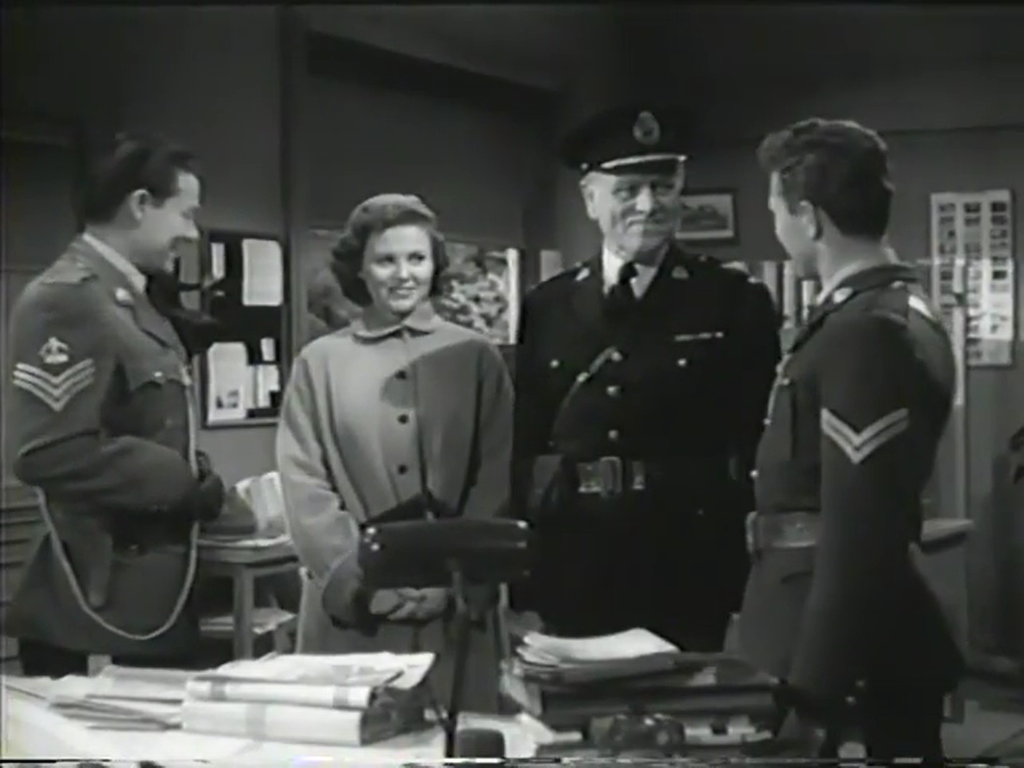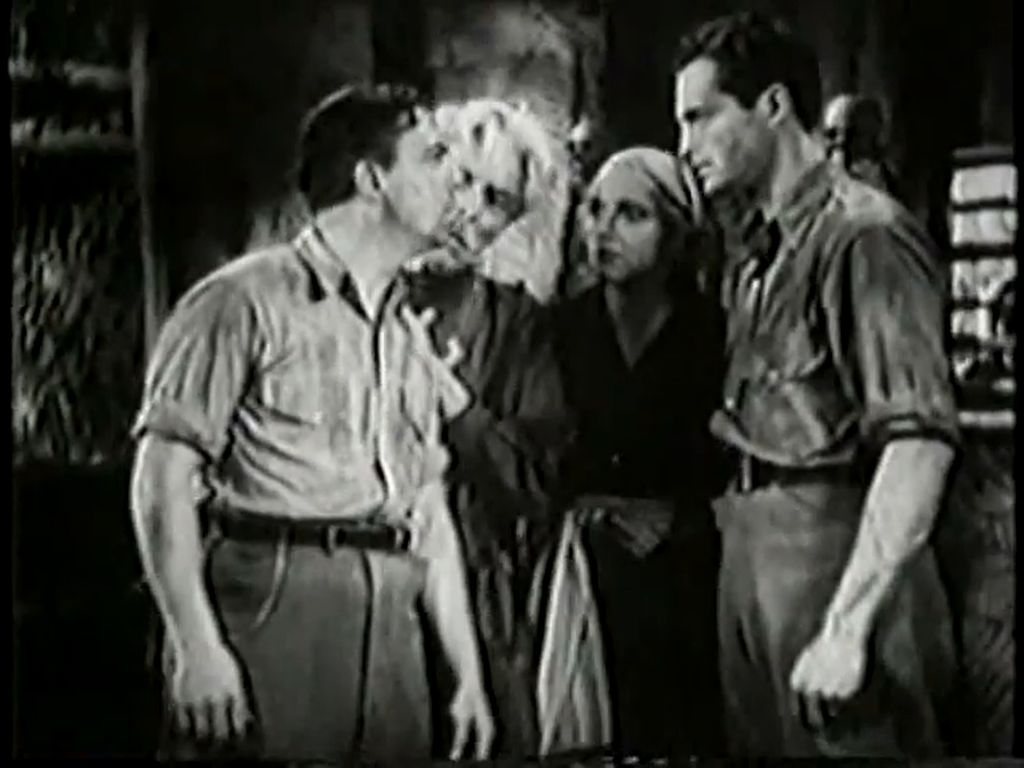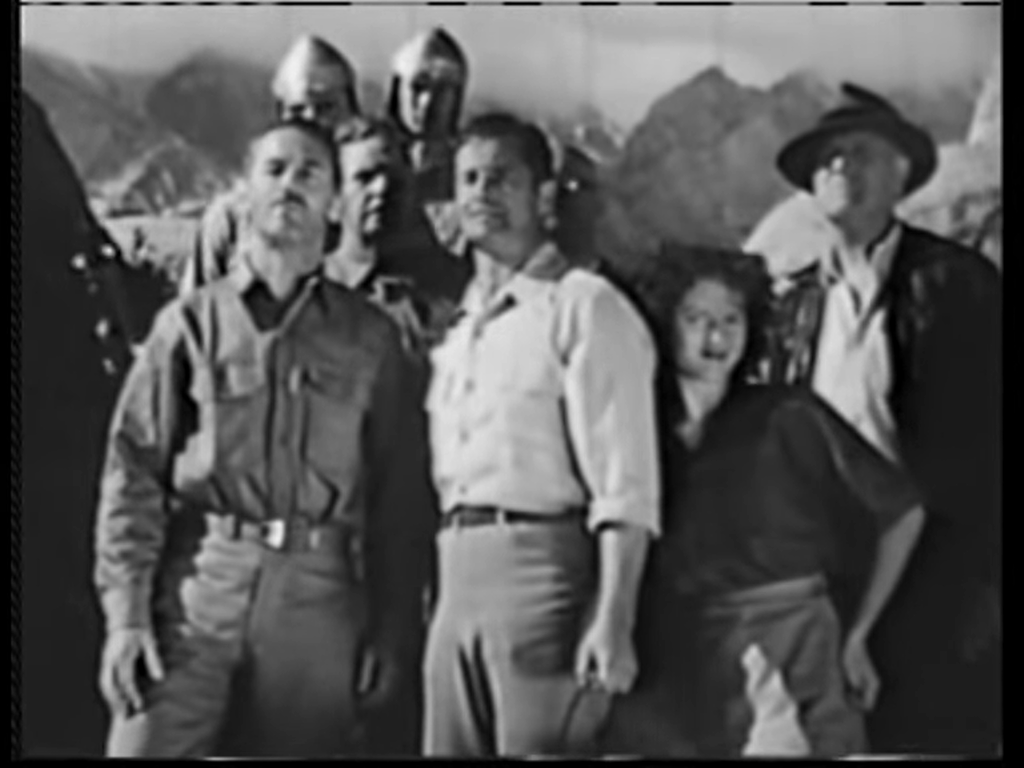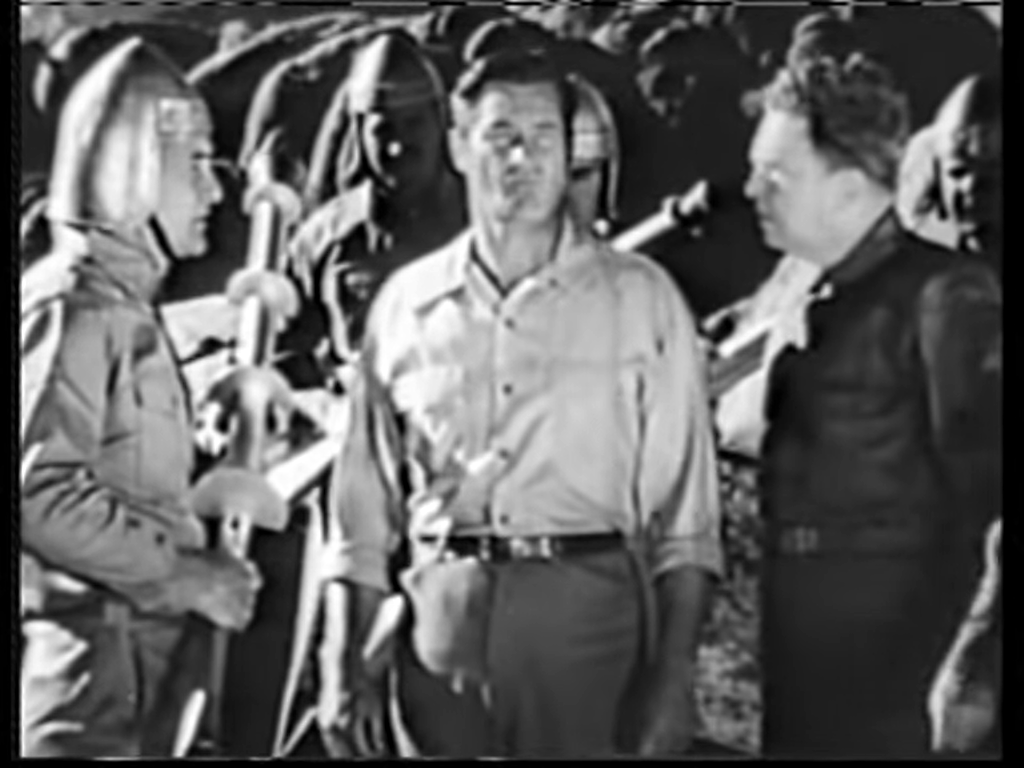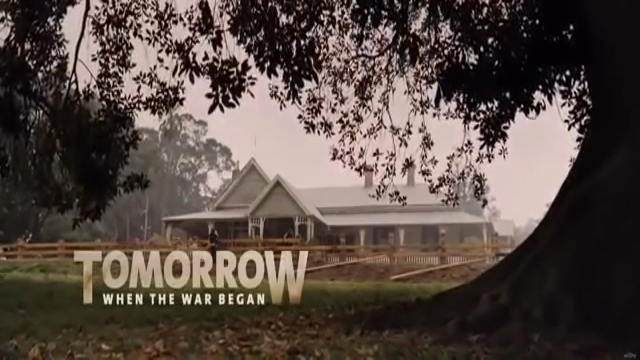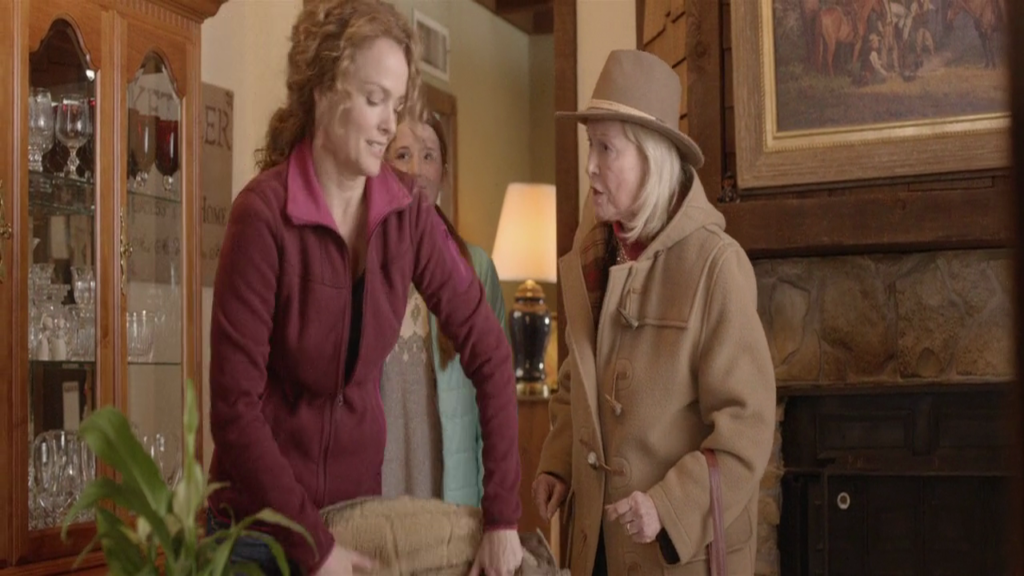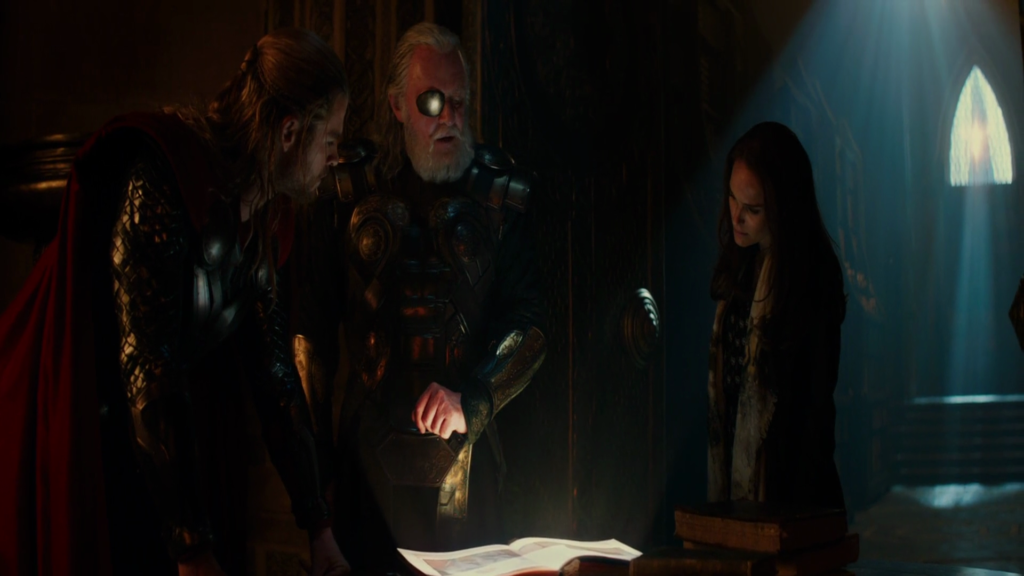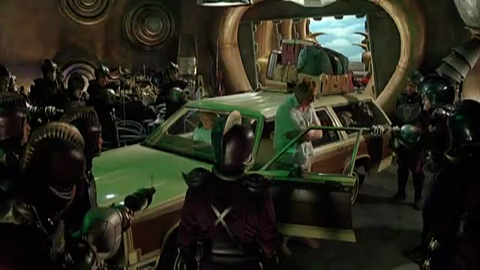-
#377 – Canadian Mounties vs. Atomic Invaders (1953)
Canadian Mounties vs. Atomic Invaders (1953)
Film review #377
Director: Franklin Adreon
SYNOPSIS: Canadian mountie Don Roberts is teamed up with intelligence operative Kay Conway to investigate reports of spies operating in the area attempting to set up covert missile bases in the Canadian wilderness. Don suspects two members of a group of settlers travelling across the wilderness are working for the spies, and so goes undercover in an attempt to expose them. Meanwhile, Beck and Reed, the spies lackeys, are secretly working to discourage the settlers from travelling to the site where Marloff, the foreign spy, wants to build his missile bases…
THOUGHTS/ANALYSIS: Canadian Mounties vs. Atomic Invaders is a 1953 serial. I think the title alone should grab anyone’s attention, so let’s see if there’s any substance underneath it…
Mountie Don Roberts is visited by his boss and intelligence operative Kay Conway to investigate the presence of foreign spies in the area. They believe that some of the settlers moving through the town are working for the spies, and so Don goes undercover with them to try and uncover their identity and motives. The first part of the serial sees Don travelling through the wilderness with these settlers as he tries to foil the spies schemes. This leads a variety of associated perils such as avalanches, dog-sled chases and other such perils of the wilderness. These sorts of sequences you don’t see too often in these serials of the time, so it is something a little different. The main plot of the serial though is nothing too special, with a constant back-and-forth chase between the heroes and villains. The “atomic invaders” are just plain foreign spies and also not very interesting. In 1953, these kinds of serials were dwindling in number as studios turned towards the feature film (and the b-movie), and the introduction of television would mean that these serials would be viewed at home each week rather than getting people to go to the theatre. With that in mind, the chapters are all (with the exception of the first one) just over thirteen minutes long, which seems a waste of effort going to see such a short film. I suppose a positive of this is that the chapters aren’t drawn out with pointless dialogue and scenes that go nowhere…but that said, there is still plenty of it to fill out the time…
After Don foils Marloff’s (the foreign spy) plans to stop the settlers, the spy changes the location of his proposed missile sites which will destroy the U.S. cities to allow his country to invade with little resistance. This “foreign country” is never mentioned by name, but since the cold war was beginning to get underway at the time, I think it’s fairly obvious which country they are referring to. The rest of the serial involves a more usual set-up of fistfights, car chases and cliff hangers that will be familiar to serial watchers. Again, at this time, the format really had been exhausted, and it can offer no real surprises or originality. Some serials hide the identity of the villain until the very end so as to maintain a sense of intrigue throughout, but this serial does not. It might have been a good idea to keep the identity of Smokey, a village resident who is Marloff in disguise, a secret until the end. Instead, it reveals it almost instantly, and the conflict between the heroes and villains really lacks any dynamic.
Given that the film has a variety of scenes in different locations, there is a lot of stock footage used and shots in the wilderness are cobbled together in a studio with painted backgrounds that look rather unconvincing. The chase scenes in cars and boats look alright, and the explosive cliffhangers have an impact, but the format leaves every twist in the story all too predictable, and despite the bizarre title, Canadian Mounties vs. Atomic Invaders fails to contribute anything unique to a formulaic format.
-
#376 – The Mad Monster (1942)
The Mad Monster (1942)
Film review #376
Director: Sam Newfield
SYNOPSIS: Dr. Cameron, a scientist, has been experimenting with genetic modification, a practice which has left him the subject of ridicule and forces him from his university job. Out in the country, he experiments on his hired help Pedro to turn him into a werewolf, but when Pedro starts killing people in his werewolf form, Dr. Cameron finds it increasingly difficult to keep his experiments a secret…
THOUGHTS/ANALYSIS: The Mad Monster is a 1942 horror/sci-fi film. The film centres around Dr. Cameron, a scientist whose experiments in genetic engineering have left him ridiculed and cast out of the scientific community. He moves out into the country with his daughter Lenora to carry on his experiments, using his hired help Pedro as a test subject. Cameron successfully develops a serum that can turn Pedro into a werewolf-like creature, which ends up escaping and killing a little girl. Pedro is unable to remember the time when he is transformed, so Cameron uses this to his advantage to take revenge on those that ridiculed his research. The story is quite straightforward, and there’s no real surprises. The plot is all explained at the beginning, and it is up to the characters to unravel the mystery themselves. there’s nothing really special about the film, it’s another simple story of science going too far that has been done many times before (and after).
The film attempts to create a horror atmosphere through some creative use of lighting and dark, minimal sets. Although all the violence happens off-screen (this is the 1940′s after all), so it is difficult to get much of an idea of how vicious this werewolf creature is. The cast of characters is pretty bland, but well defined, and everyone contributes to the story in some way. The acting and delivery of lines is sometimes a bit flat, but credit to the actor playing Pedro, who gives an expressive performance. One of the biggest drawbacks of the film is that it often feels boring, with scenes that drag on too long consisting of dull conversations that go nowhere. You become very aware of the beginning and ending of scenes as they mostly end on flat notes without much fanfare, leaving you to wonder what the point of it was.
As mentioned, the production values of the film are rather low, owing to the general state of the world at the time and having more pressing issues to address. Nevertheless, there are a few positives, such as Pedro’s “werewolf” make-up or costume being quite well put together. Sometimes Dr. Cameron delivers a good speech under an atmospheric light, but other than that there’s really not much else that stands out. The Mad Monster is an entirely forgettable film with a typical message of science going too far, and a blandness in terms of its looks and its dialogue leave little to recommend it.
-
#375 – The Lost City (1935)
The Lost City (1935)
Film review #375
Director: Harry Revier
SYNOPSIS: Extreme weather is causing mass destruction across the Earth, with seemingly no known explanation. Electrical engineer Bruce Gordon manages to use one of his machines to trace the source of these disturbances to an unexplored region of central Africa. He leads an expedition to the area to investigate and ends up discovering a lost city ruled by a madman who is intent on attaining absolute power from his machines. Bruce must join forces with the various people in the region, and stop the evil Zolok from using his machines before the world is destroyed…
THOUGHTS/ANALYSIS: The Lost City is a 1935 science-fiction, twelve part film serial. in the opening, we see storms ravaging the cities of the world, causing mass destruction. The world is unable to find the cause of these freak weather events, until electrical engineer Bruce Gordon uses one of his inventions to locate the source in an unexplored region of central Africa. Bruce leads an expedition to the area withe his friend Jerry Delaney, and when he arrives at a trading post, a man named Butterfield stumbles in injured, telling of a lost city beneath Magnetic Mountain guarded by giants. Believing there is a connection between Magnetic Mountain and the storms, Bruce investigates and finds the lost city is real. There, a man named Zolok is forcing Manyus, a scientist, to construct inventions which he believes will help him rule the world. The opening chapter of the serial is typically full of exciting effects and setting the stage for a thrilling adventure. As I’ve mentioned before in other serial reviews, the opening chapter is often the most thrilling and interesting, as it is meant to entice viewers to return to the theatre every week to watch the subsequent parts. These serials can quite quickly run out of steam, as they are made on a low budget and there is a lot of re-used settings and back-and-forths between the heroes and villains that can get repetitive. With The Lost City though, this repetition is kept to a minimum as there’s a number of distinct locations, and a large cast that gets introduced as the story goes on, so these new elements continually change the dynamic of the plot. Of course, there’s also plenty of daring cliffhangers at the end of each chapter, with lion pens, giant spiders and all sorts of devious traps that will encourage viewers to return next week. The overall story is definitely stronger than many similar serials I have seen.
As I mentioned, the cast is fairly large, and are somewhat diverse. The “giants” are pretty cool, and have a menacing presence. The big problem here though, with the film being set in central Africa, is the film’s depiction of non-white races. The “native tribes” are portrayed as very typical, primitive people as very much stereotypes of what western countries at the time were taught Africa to be. The fact that the film does not further pinpoint the location other than “Africa” again shows how the entire continent is ill-defined by said countries. When the “Arabs” shows up around half-way through the serial, they again are portrayed in a stereotypical fashion. Both of these groups, when they are supposedly speaking in their own language, is clearly just gibberish being shouted by the actors, which again just reinforces the dismissive attitude to non-white cultures. i think the main villain is designed to be similar to an east Asian person as well, just to round off the serial’s inclusion of all races. The portrayal of the black giants is clearly meant to make them as menacing as possible too. On top of all this, there is a plot element that Manyus has invented a medicine that can turn black people white. While the film does not label this as a “cure” for being black, it does feel that way at points, and really just compounds the fact that this film is horrifically outdated, and racially dismissive/ignorant.
The Lost City really shines through in terms of its story, and it paces itself well throughout the twelve chapters by continually introducing new characters and dangers in order to keep things fresh. In this respect, it avoids one of the significant problems that plague the serial format. However, it’s depiction of non-white races is horrifically ignorant and outdated, and really is non-redeemable. Yes, it is a product of it’s time, but I do not feel that it is enough of an excuse to dismiss its harmful racial depictions.
-
#374 – The Last Halloween (1991)
The Last Halloween (1991)
Film review #374
Director: Savage Steve Holland
SYNOPSIS: In the town of Crystal Falls, Michael and his younger sister Jeanie are eager to celebrate Halloween, but their Father, who owns the local candy factory, fears this will be “The Last Halloween” as the lake that powers the factory is mysteriously drying up. When aliens show up looking for something called “koobi” which their home planet of Mars has run out of, Michael and Jeanie help them to find some and unravel the mystery of the lake along the way…
THOUGHTS/ANALYSIS: The Last Halloween is a 1991 TV film/special aired at Halloween (Unsurprising, given the title). In the opening we are introduced to Michael and Jeanie: a brother and sister who live in the quaint U.S. town of Crystal Falls. Their Father and grandfather run the local candy factory, which is about to close down due to the mysterious drying up of the lake, which will make a lot of the town unemployed. Michael and Jeanie are still looking forward to going trick or treating however, and their Halloween night gets even stranger when four aliens land on Earth looking for something called ″koobi” which their home planet of Mars has run out of. Michael and Jeanie agree to help the aliens out, but meanwhile Mrs. Gizbourne is secretly using the water from the lake to fuel her experiments into attaining the secret of eternal youth. For a television special that only runs at around twenty five minutes, there is a lot going on in terms of story and characters. It crams a lot in so that in theory there’s something for a wide audience. It skips a lot on some of the details, but that kind of thing doesn’t really matter to kids, who can happily fill in the gaps with their own imagination. With all these different threads going on at the same time, the special nevertheless flows along quite nicely, and there’s always something fun or interesting happening on screen.
The film is definitely meant to have a “timeless” quality to it, so it can be repeated every year when halloween rolls around. It’s meant to be the sort of film that becomes part of the tradition, although it wasn’t shown much after it’s original airing as far as I can see, and there’s been no digital or home video release. Michael and Jeanie are plain and average children that younger viewers can relate to, but they have their own unique traits too. The aliens are probably the most interesting characters though, as each has their own look, voice and personality, and are entirely computer-animated, which was quite groundbreaking at the time have CG creatures interacting with real actors on-screen. This special was made my Hanna-Barbera, who produced a lot of traditional hand-drawn animated shows (Scooby-Doo, The Flintstones, amongst others), and this is one of their first forays into computer-generated animation. Nevertheless, they seem to have transitioned well, and the aliens all look, move and talk like they have a genuine presence. Obviously the effects look dated now, but again there is still a timeless quality to them that doesn’t spoil the overall feel of the story.
Overall, The Last Halloween, while being short and fairly harmless, manages to cram a lot of content into its runtime, with plenty of elements that will appeal to its younger audience. It plays it safe in many respects and is mostly harmless, probably appealing to well-established ideas to make it “timeless”, but owing to that, it does use what is known to be successful to make a successful bit of television. The animation is fairly decent for it’s time, and offers something new in terms of it being computer generated. Not that interesting for adults, but would have been perfect to get young kids in the mood for Halloween.
-
#373 – Brick Bradford (1949)
Brick Bradford (1949)
Film review #373
Director: Spencer Gordon Bennet
SYNOPSIS: Brick Bradford and his friends are assigned to visit the lodge of the scientist Doctor Tymak, who has developed “interceptor ray” that can intercept and destroy enemy rockets. It’s potential to be developed into a death ray as well has attracted the attention of the foreign spy Laydron, who wants to steal the ray. Brick and his friends must fight to keep the ray from falling into the wrong hands, and help Tymak finish his research as they travel across time and space to defeat the villainous Laydron and his goons…
THOUGHTS/ANALYSIS: Brick Bradford is a 1949 movie serial based on the comic strips of the same name. The opening introduces Brick Bradford and his friends Sandy Sanderson (yes that is apparently his real name), Professor Salisbury and his daughter Jane. They are visited by a U.N. official to assigns them to aid the work of Doctor Tymak, a scientist working on a secret project who may be the target of foreign spies. The spy Laydron manages to get to Tymak first, and while Tymak flees, Laydron pretends to be him when Brick and his friends get there in order to capture them. The plot of the serial follows the standard serial setups, with a constant back-and-forth between the heroes and villains, fist fights, getting captured, escaping and daring cliffhangers. I suppose what makes the serial unique is that it is a mix of all the usual elements of the format thrown together into one. For example, the opening third deals with Tymak fleeing to the moon after Laydron trying to capture him and Brick going to rescue him. While there, they get caught up in a civil war between a dictator and the rebels who want to restore democracy. This part of the story is very similar (practically identical) to a Flash Gordon serial, and while it will offer no surprises to viewers familiar to said serial, it offers an interesting setting and some fun traps. The next part of the film involves Brick and Sandy going back in time to find a note buried in a treasure chest that has the formula necessary to complete the interceptor ray. They get caught up in a battle between some sailors and a native tribe and the whole setting again offers something different. The third act revolves around the more standard serial plots of kidnapping, fist fights and chases as Laydron tries to get a hold of the interceptor ray. Add to all this the car chase scenes, invisibility devices and convoluted death traps and you’ve got a full-house in movie serial bingo.
The problem with the story is that while it does have plenty of variety, its different parts feel inconsistent with each other. The first part set on the moon is very similar (identical) to a Flash Gordon serial, and is probably the best written part, with a host of identifiable characters and plenty of danger and traps. The second part set in the 18th century is a bit more light-hearted and silly. With Sandy often making plenty of humourous quips. After these adventures throughout space and time, the final part resorts to the typical back-and-forth between the heroes and villains as they chase each other across the few sets the serial has. This is the weakest part of the serial, as it is difficult to top the first two parts. One reason for this disparity is that each part is written by a different writer, and clearly they all have their own ideas of what should be going on in the serial. The director, Spencer Gordon Bennet, did a number of these film serials, but his expertise doesn’t really fix the problems (he also directed the Batman and Robin, serial and after Brick Bradford the Superman serials, which were much better).
The movie serial format is a very outdated format. It’s multiple episodes re-used the same few sets as they were typically constrained to a low budget and would have to stretch what they had as far as possible (yet would keep viewers coming back to the theatre every week to watch the next instalment). Brick Bradford manages to have a good enough variety of settings thanks to the varied story, and is also aided by the fact that there are plenty of outdoor scenes. Obviously the moon having a breathable atmosphere and people living on it is a bit far-fetched today, but would have been somewhat believable back when the serial was released. The “time top” that Brick and Sandy use to travel back through time in is probably one of the first depictions of a time machine on film too, and I can imagine that it sparked people’s imaginations when they saw it for the first time. The characters themselves are all a bit dry and without merit, and Brick doesn’t really stand out alongside the Flash Gordon’s and Buck Rogers’ of the movie world. Overall, Brick Bradford can best be summed up as a “greatest hits” of the sci-fi movie serial: it has everything it needs from death rays, aliens, time travel, invisibility devices, mobs, car chases, convoluted death traps, all-american heroes, and a single female character. However, all of these elements feel very disjointed from one another, and the mix of writers with different perspectives gives the serial an uneven tone. There is a decent amount of variety throughout the fifteen chapters, but by the end the film has exhausted everything the format has to offer and it clearly shows. A valid attempt with familiar concepts, but nowhere near the best that the serial format has to offer.
-
#372 – Tomorrow, When the War Began (2012)
Tomorrow, When the War Began (2012)
Film review #372
Director: Stuart Beattie
SYNOPSIS: Seven teenagers in rural Australia go off into the wilderness for a weekend camping trip, but when they return, they find that while they were away, a foreign army has invaded the country, and rounded up all of their families. The group are hunted by the occupying forces, and must not only find a way to survive, but to fight back and save their town…
THOUGHTS/ANALYSIS: Tomorrow When the War Began is a 2012 Australian film based on the novel of the same name. The film centres around a group of teenagers who have to survive when their country is invaded by a foreign power. In the beginning, we are introduced to Ellie, a normal teenager who narrates the story, and is organising a weekend camping trip with her friends into an area of the wilderness literally called Hell. While they are away with no way to contact anyone, a foreign army invades Australia and takes over their town, as well as imprisoning all their families. When Ellie and the rest of the group return home to find everyone gone, they have to find a way to first of all survive, then figure out how to fight back. The film is quite similar to Red Dawn, which really remains the benchmark for these types of films. The plot unfolds steadily and more or less predictably, but given the constant danger that the cast is in, it creates a tense atmosphere in which you can believe that no one is safe, and danger could just be around the corner. The film exclusively centres around the cast of teenagers, and for most of the film they are just trying to survive before they can actually start to fight back. We don’t see their families captured, and neither do they try and free them because they are too busy just trying to avoid getting captured themselves, which sort of makes sense. The film also has a ‘coming-of-age’ feel to it as the characters are forced to grow up and confront adulthood a lot sooner than they were expecting. There is a lot of suspense in many of the scenes throughout the film, and a constant sense of danger that is executed well, driving many of the decisions that the characters take.
The most interesting part of the film is definitely the characters. Each of the teenagers that make up the group has their own recognisable personality, and a good amount of focus is given to each of them to see how they deal with the situation they find themselves in. The inter-personal relationships between them also get a good amount of attention, and so while some of the characters fall into very stereotypical roles, they develop unique relationships and responses throughout the film, which makes keeps it interesting. Being based on a book, you can certainly see where the characters were specially developed in the text and translated into film well. Sometimes there’s a corny line of dialogue that feels out of place, and takes you out of the drama of a scene, but the overall impression of the characters you get isn’t hampered by this. They really are a balanced bunch with elements of romance and animosity to give it some variety, and plenty of opportunities by the end of the film to overcome their shortcomings and truly ‘come of age’ (even if, again, it sometimes feels a bit corny or obvious). Ellie certainly leaves a strong impression as she starts as an ordinary teenage girl and quickly becomes scarred and hardened by the trouble she goes through (such as having to kill the enemy soldiers), but also has to contend with her still human side. Kevin’s cowardice is a constant burden to the group, but by the end he finally finds something to stand up for. Homer’s unruliness finds a place in executing and planning guerrilla tactics, Fiona is a bit of a princess, but isn’t afraid to confront her humanity and help out despite being aware of her limitations, and Robyn realises that following her religion isn’t so simple when she also has her loyalties to her friends who are also counting on her. Again, these are interesting characters to watch that evolve beyond the familiar stereotypical roles they begin in through well written dialogue and relationships.
The balance between drama and action is well maintained, and the scenes are well constructed to serve their purpose. There’s some great shots of the Australian wilderness which really define the location well and give it a unique sense of identity (while the themes in the film are familiar, they are rarely set in this part of the world). The soundtrack is full of fitting songs, and the production and direction is well executed. The film never gets too over-the-top, and while not overly violent or gruesome, does not shy away from the harshness of what is going on, which again accentuates the need for these characters to grow up quickly and confront their weaknesses. The plot eventually centres around the group attempting to blow up the only bridge in and out of town, thereby cutting off reinforcements from the nearby port. The film ends with their success, but with the war far from over and their families still imprisoned, they obviously have a long way to go. There were several more books that continued the story, but none of them were adapted into a film, which is a shame because by the end of the film the cast becomes very familiar and you are certainly left wanting more from them. Tomorrow, When the War Began follows familiar themes and tropes, but branches out to develop it’s characters and unique location in an interesting and refreshing way, and keeps the viewer engaged with tense action scenes and emotional drama. There’s the odd line of dialogue or performance which falls flat and interrupts the investment in the film, but overall it’s an entertaining and captivating watch.
-
#371 – Pokémon: Detective Pikachu (2019)
Pokémon: Detective Pikachu (2019)
Film review #371
Director: Rob Letterman
SYNOPSIS: When Tim Goodman gets news that his Father has been killed in a car crash, he travels to Ryme City where he worked as a police detective, to collect his things. While there, he finds a Pikachu who for some reason he is able to understand. Tim also learns that this Pikachu was his Father’s pokémon partner, and he has had his memory wiped. Tim decides to team up with Pikachu to help him regain his memories and carry on the case that he and his Dad were working on before he seemingly died…
THOUGHTS/ANALYSIS: Pokémon: Detective Pikachu is a 2019 film based on the successful video game franchise, and loosely follows the 2016 game Detective Pikachu. The film starts off introducing Tim Goodman, a 21-year old insurance salesman who gets news that his father has died in a car crash in Ryme City. Tim heads to the city to collect his father’s things, but while in his apartment finds a Pikachu that Tim can understand when he speaks. Not only this, this Pikachu was his father’s pokémon partner in his job as a police detective, and has lost all his memories, so Tim gets caught up in this curious mystery that he teams up with Pikachu with, to try and work out what happened to his father, and what happened to Pikachu’s memories. The plot of the film is focused on unravelling this big mystery, which impacts on each of the characters, but becomes tied into the fate of the city as a whole too, meaning it has lots of facets and interesting avenues to head down. Nevertheless, the story is fairly simple to follow, while also offering some decent twists along the way. The different elements of the plot perhaps don’t weave together enough though, as scene-by-scene it focuses on either story, action or emotional aspects, and they don’t overlap too much. With this in mind the villain’s big plan can feel a little muddled, especially in comparison to the much more interesting mystery concerning Pikachu and Tim’s father.
It should be noted that you don’t really need to have an extensive knowledge of Pokémon to enjoy this film: it is easy enough to follow the mystery without knowing what all the pokémon are. Nevertheless, the film is clearly aimed at fans of the franchise, and there’s a ton of little references that will satisfy the hardcore fans, and they will be the ones who get the most out of this film. Every pokémon has their own personality and comes alive on the screen, and while the human characters sometimes do not possess that amount of presence, they have their own specific roles that they play out well. Overall the film is easy to follow, and offers plenty of entertainment tailored to the pokémon themselves.
One of the most noted aspects of the film are the pokémon visuals: they have a unique aesthetic that maintains the original designs, while also making them more ‘believeable’ in the real world, such as accentuating the fur on Pikachu and others. Altering and adapting character designs is always a challenging task to pull off, as any alteration will no doubt anger fans and purists. However, Detective Pikachu seems to have struck the perfect balance with it’s designs: it makes the pokémon more ‘real’ looking, while also keeping the proportions and feel of the original designs, which went over well with the significant majority of fans. Sometimes the CG lets itself down (particularly with regards to Mewtwo), but on the whole it is pretty solid. The pokémon are also full of character, and their facial expressions (especially Pikachu’s) really bring them to life. Ryme City itself has its own unique aesthetic as a mix of London, New York and Tokyo, while also bringing in its own original elements to give it a feel of something new and also as a distinct place in the pokémon universe. Overall, Pokémon: Detective Pikachu is a success in translating the franchise into a live-action setting for the first time: it offers something new without deviating so much that it is unrecognisable to fans. The story is easy to follow, and the characters are entertaining, and the negatives don’t detract too much from the overall enjoyment. I think the film really is intended both for die-hard fans and (equally) also for those who were only into the franchise when they were a kid many years ago, and will appreciate the nostalgia trip. Even with all the new pokémon they would have never seen before, there’s still plenty of classic pokémon they will recognise and enjoy seeing again.
-
#370 – Amerigeddon (2016)
Amerigeddon (2016)
Film review #370
Director: Mike Norris
SYNOPSIS: In the near future, where the president of the United States has signed over much of the country’s power to the United Nations, the governing body secretly launches an E.M.P. at the country to disable all electronics and use the attack as an excuse to declare martial law and to confiscate everyone’s guns. A group of people band together and decide to fight against the ‘tyranny’ of the United Nations occupying forces, and defend their second amendment rights.
THOUGHTS/ANALYSIS: Amerigeddon is a 2016 film and clearly meant to be a ‘warning’ about the dangers of Americans having their guns taken away n order for them to protect themselves against an overreaching government. The film starts off with a dire warning about the the dangers of an all powerful government, which will possess the ability to remove it’s citizen’s rights and sign them away to the “new world order”. This phrase is the typical boogeyman of the right-wing for which this film was obviously intended for to fulfil their fantasies of fighting back against their government, and it is constantly throwing the phrase out to try and make it sound as evil as possible. Using some out of context clips of politicians using this phrase (including the right wing’s other boogeyman, Barack Obama) to again create this all encompassing enemy of the people. Let’s be completely clear why this film was made: to scaremonger people about the possibility of the evil government coming to steal their guns (not that it is going to convince anyone other than those who hold those beliefs), and to fulfil the fantasies of those who think that they will one day be American heroes by using their guns to fight the oppressive regime of the new world order, or something equally implausible.
The story is set in the near-future, where the government and successive presidents have signed over most of their powers to the United Nations, who also see American citizens with guns as domestic terrorists. An E.M.P. is launched at the country and knocks out all of the power, giving the government an excuse to declare martial law and confiscate all of the citizen’s guns. Society descends into chaos as the characters find their way to each other to form some sort of resistance. It is quite apparent that this whole plot makes no sense…basically because the whole fantasy of rising up against the tyrannical new world order also makes no sense. Firstly, characterising the U.N. as an evil organisation intent on world domination is ridiculous and has no basis in reality. Secondly, what possible benefit would there be to destroying all the electronic devices in the U.S.? Given that a lot of global companies and assets are there, it doesn’t make any sense to wipe them all out. Thirdly, why would the new world order, if it really had control over all the governments in the world, feel so threatened by a bunch of ill-trained civilians in the middle of nowhere they would need to send in their army to wipe them out? Fourthly, the story is a direct copy of the film Red Dawn, while also managing to strip out anything interesting. Trying to understand the plot of this film is like trying to decipher the conspiracy theories that fuel it: it’s not possible, because they don’t make sense in the first place. They are hypothetical scenarios (fantasies) used to justify owning weapons and funding the organisations which relies on the fantasies peddled by this film.
The characters are themselves a bland cast of politicians, soldiers, and families who you would typically associate with the idea in this film: “real Americans” like people who own ranches in the middle of nowhere. The cast is not in any way diverse, and any elements that pretend to diversify or offer alternate view points are acts of tokenism, or just turn out to be the wrong path, such as Penny’s going to a ‘liberal arts college’, only to come back home to the safety of her gun-wielding family fighting against the world’s most powerful army (seriously…). The acting is all pretty bland and stale, and there’s no originality or interesting aspects to them. This is probably intentional so that viewers can fantasise about themselves being in such a position instead, allowing them to project their fantasies into the ‘story’ with ease.
The production and special effects throughout are pretty bad. The finale is by far the worst part though, as the U.N. apparently sends a whole squad of personnel to the ranch, which consists of a few men, three vehicles and a helicopter. Again, if the world’s most powerful organisation really wanted these citizens, they would certainly overwhelm them with much more force, so again it holds no basis in reality. Also, the U.N. soldiers mostly wear blue caps with a crude U.N. logo stuck to them, and quite frankly it is ridiculous how non-threatening they look. The final fight consists of the U.N. helicopter, which clearly is just a normal civilian helicopter, against the citizen’s gyro-copter, which again in reality would stand so little chance it is hilarious. The film ends with the proclamation that they have “won the battle, but not the war…”, ominously setting up some sort of sequel, but thankfully one can hope that none shall emerge: this film is bad, in almost every aspect. I have used the term ‘fantasy’ a lot through this review, and that’s precisely what it is: a fantasy for those who think that they are patriotic heroes by amassing firearms to fight back against an oppressive government. It is a fantasy that holds no basis or credibility in reality. I would label this film as dangerous propaganda if it wasn’t so bad and unbelievably inept at getting its point across. No one is going to be convinced by the arguments in this film if you weren’t before, and for those that were it is just another hollow fantasy to indulge themselves and their bankrupt ideologies in. Terrible film about terrible ideas that can’t convey any reasonable arguments or facts.
-
#369 – Thor: The Dark World (2013)
Thor: The Dark World (2013)
Film review #369
Director: Alan Taylor
Thor: The Dark World (2013)
Film review #369
SYNOPSIS: A rare cosmological event is taking place in which the nine worlds will converge, creating disturbances across all of them as the barriers between them weaken. When Malekith, the ruler of the Dark Elves awakens, he sets about attempting to retrieve the Aether, a weapon of mass destruction he can use to return all of the world into darkness. Thor once again must protect Asgard and all other worlds as the Aether is absorbed into Dr. Jane Foster, a scientist and Thor’s love interest as Malekith attempts to retrieve the Aether by any means necessary…
THOUGHTS/ANALYSIS: Thor: The Dark World is a 2013 superhero film and the sequel to 2011′s Thor. It is part of the marvel cinematic universe. The film starts off telling the story of the dark elves and their leader Malekith, who many years ago tried to plunge the nine worlds into eternal darkness using a weapon known as the Aether. They were defeated by the Asgardians and forced into a state of suspended animation. In the present day, Thor is busy bringing peace to the nine worlds while a cosmological alignment of the worlds is beginning to take place, which is creating anomalies among them. Dr. Jane Foster on Earth is investigating some gravity distortions when she enters another dimension and absorbs the Aether into her body. her love interest, Thor, shows up and takes her to Asgard to treat the illness brought about by the Aether and to investigate it’s true purpose. Meanwhile, Malekith and his army have revived and plan an all out attack on Asgard in order to seize the Aether and again attempt to plunge the worlds into darkness. The plot of the film is varied, with a decent amount of action, drama and humour, but the main problem is that it just doesn’t fit together very well: the individual scenes themselves are decent, but the whole “cosmic alignment” and “plunging the world into darkness” elements are tropes that have been done to death, and offer very little surprise or interest to tie everything together. This is furthered by the moving around between Earth and Asgard that constantly shifts the focus of the film, and makes the different scenes have little relevance from one to the next. There is some effort made to give the characters a stake in the story, but again it seems to get diluted in the myriad of things that are going on, and the non-descript villain plot that is fairly standard.
The film’s strongest points are in it’s character interactions, particularly in the relationship between Thor and Loki. Following the events of The Avengers, Loki is imprisoned for life on Asgard for trying to take over Earth, with only his Mother coming to occasionally visit him. When Thor and Loki’s mother is killed By Malekith, The two brothers forge an uneasy alliance in order to get their revenge. Loki’s constant trickery and Thor’s righteousness really work well together, both as drama, and also from a humour perspective, giving them an ample amount of bickering that is fun to watch. Unfortunately, there isn’t enough of it. The whole romance between Dr. Foster and Thor doesn’t really develop from where it starts, and again is overshadowed by the Thor/Loki dynamic. Other characters play their part, but contribute very little, again because the scenes are so disparate they often fail to make an impact on the whole. An example would be the death of Thor/Loki’s mother, which isn’t mentioned at all after the funeral, and just gets forgotten.
For all these shortcomings, there are some positive points. Asgard looks great, and the action is fairly solid with a few surprises. The humour again serves as some light relief from the drama, and there’s a decent mix of all these elements. Unfortunately the plot as a w hole is fairly weak, and manages to make all the events in the film – even if they are about the end of the world – seem pretty inconsequential. Add to that the plot relying on a serious amount of coincidences that make less sense the more you think about them, and it is easy to see why people consider this film the weakest in the Marvel Cinematic Universe. It’s not completely terrible, but at this point in the cinematic series, the viewer is no doubt expecting a more complex contribution with a more expansive story, which Thor: The Dark World does not fully deliver.
-
#368 – Mom and Dad Save the World (1992)
Mom and Dad Save the World (1992)
Film review #368
Director: Greg Beeman
SYNOPSIS: Dick and Marge Nelson are driving on their way to spend the weekend away for their anniversary. On the way, they are abducted and taken to the distant plant Spengo, where it’s evil emperor Todd intends to marry Marge himself before he destroys Earth with his “Super Death Ray Laser”. Dick must find a way to rescue his wife and save the Earth while also contendng with the local rebels and a bad back, so it probably won’t be easy…
THOUGHTS/ANALYSIS: Mom and Dad Save the World is a 1992 sci-fi comedy film. The film starts by introducing married couple Dick and Marge Nelson, who are about to drive on their anniversary getaway. However, they end up going a lot further than expected, as their car is abducted and taken to the far away planet of Spengo, where the ruler of the planet, the evil emperor Todd plans to marry Marge himself before blowing up the Earth with his “Super death Ray Laser”. The plot really is this simple, and essentially revolves around Todd trying to marry Marge, and Dick trying to stop him and rescue his wife. From the outset we see the couple are pretty average, with kids and some issues between them, but nothing that majorly stands out: Marge wants to be more adventurous, while Dick is unwilling to go beyond his comfort zone. Meanwhile we see the evil emperor Todd is a bit of an incompetent and non-threatening villain (not least because his name is Todd), and the whole film just has that cheesy, silly tone to it that shows it is not meant to be taken seriously. I suppose it is primarily a comedy film with some sci-fi and adventure elements as this middle-aged couple attempt to overthrow this not-so-evil dictator. The pair make for unlikely heroes, although their characters don’t offer too many surprises, it is unusual to see those types of characters in this type of situation, so it does make for a bit of a unique experience.
Although the film offers little surprise in terms of story or characters, there are some more noteworthy aspects to it. Firstly, there are enough jokes that land to make this film entertaining enough to sit through. There’s some occasions where it can get a genuine laugh, and others where it maintains the humour throughout, such as the “light grenade” scene. Most of the humour is family friendly, but there’s some jokes only an adult will get, so there’s a variety in there that will appeal to a wide range of audiences. Most of the humour however is pretty goofy and slapstick, as the planet Spengo is self described as a “planet of idiots”, and the plainly average Dick is regarded as a genius compared to them. Another positive to the film is the some of the production aspects. The alien costumes, which are anthropomorphic dogs and fish, are quite well done, and are able to convey a range of facial expressions that give them real character. The rest of the special effects are fairly typical of their time, but there’s clearly a decent amount of effort gone into creating the setting and characters. One other interesting note is that the actor for Todd voices Artie in The Simpsons, who on more than one occasion also attempts to steal Marge from her husband, making a very obscure reference.
Overall, Mom and Dad Save the World is a rather average film. It’s premise is silly, and it delivers some silly humour as you would expect. There’s some genuinely funny moments using a range of humour, and the costume designs are pretty good, so while not being the most stand-out film of all time, manages to be entertaining enough to warrant sitting through it.

